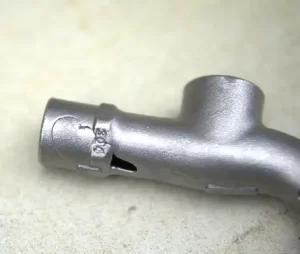Causing deformation problem of precision castings
During the production process of precision castings also called investment casting, due to some hardware facilities, management, pouring cooling and correction issues, casting deformation problems will occur. So how should we deal with casting deformation when we encounter it?
The deformation of castings is divided into: micro self-deformation, flaring deformation of castings and warping deformation.
Micro self-deformation: Among alloy materials, gray cast iron is most susceptible to micro self-deformation. After gray cast iron casting parts is shaken out from sand shells and cleaned, the residual stress that exists is mainly residual thermal stress. In addition to causing defects such as cold cracking and deformation of castings, residual stress is also the main cause of micro self-deformation. Even if the residual stress does not exceed the yield strength of the material, under its action, gray cast iron will slowly undergo micro-plastic deformation over time. This deformation is called micro-self-deformation.
Flaring deformation: The reason is that the sand core or sand mold at the opening size hinders the shrinkage of the casting, causing plastic deformation of the free structural part of the casting opening, resulting in flaring deformation defects.
Warping deformation: After the sand cleaning, the casting has warping deformation at both ends or one end or even the peripheral edge, causing the middle part of the casting to be concave, causing the casting to be uneven. This form of deformation is called warping deformation. The reason for its formation is: when the casting is cooled, the thickness of the casting is uneven, and there is a temperature difference, which causes different cooling rates in various parts of the casting, resulting in uneven plastic deformation, resulting in warpage deformation.

How to deal with the deformation problem of precision castings?
Regarding the deformation problem of precision castings, our engineer mainly puts forward four relevant suggestions:
- Before shooting wax, first find the mold and preset it in the wax shooting room. Do not start shooting wax until the temperature of the mold is the same as the room temperature of the wax shooting room. As for the temperature of the wax parts during shell making later, there is no need to mention it because there is problem or not controlling well, it will break directly.
- After the wax parts come out, they should be self-inspected first, mainly to check whether there are deformations or other defects during the mold removal process; the wax parts should be neatly placed in a uniform way, or usually put into water tank, that will make the wax pattern floating to avoid deformation and help cooling fast, and try to avoid overlapping and hanging in the air; it is recommended to use the best quality for finished product shipments Fixture inspection to improve detection speed and accuracy, and calibrate the fixture according to a certain period.
- After coming out of the furnace, when the temperature of the modules is still very high, avoid overlapping and place them regularly so that the deformation direction is consistent for easy shaping, correction and clamping.
- The jig for calibrating castings should be made of hard materials, and the surface should be wear-resistant. For some parts with relatively large areas, the tonnage of the press or punch should be reasonably calculated to avoid waste of equipment or insufficient strength.
Precision castings have a great impact on the performance of mechanical products. Poor quality precision castings will seriously affect the service life of mechanical products. Therefore, once problems such as deformation of precision castings are found, timely corrections must be made to prevent precision castings from affecting mechanical products. performance.
